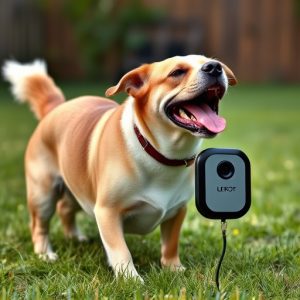Mounting Options for Electronic Dog Deterrents: Training and Safety Insights
Sound wave pet behavior control, using high-pitched frequencies, offers a non-lethal method to train…….
Sound wave pet behavior control, using high-pitched frequencies, offers a non-lethal method to train pets, preventing behaviors like barking or jumping. Electronic dog deterrents, with various mounting options, emit these ultrasonic waves when triggered, causing discomfort. The ideal mounting choice depends on the dog's habits and space constraints, ranging from indoor wall mounts to outdoor pole installations. Proper training and strategic placement ensure safe and effective pet behavior control tailored to specific needs.
Sound wave pet behavior control is an innovative approach to managing animal behavior without traditional restraint. This article delves into the science behind electronic dog deterrents, exploring how sound waves can be used to modify pet behavior. We discuss various mounting options for these devices, highlighting their benefits and considerations for safe use. Additionally, training guidelines are provided to ensure effective implementation. By understanding the science and practical aspects, owners can effectively navigate this modern solution, enhancing their pets’ well-being and living environments.
- Understanding Sound Wave Pet Behavior Control
- The Science Behind Electronic Dog Deterrents
- Exploring Different Mounting Options
- Benefits and Considerations for Use
- Training and Safety Guidelines
Understanding Sound Wave Pet Behavior Control
Sound wave pet behavior control is a non-lethal and humane method that utilizes specific frequencies of sound to modify an animal’s behavior. By offering a wide range of mounting options for electronic dog deterrents, this technology allows for flexible deployment in various settings, from homes to public spaces. These devices emit high-pitched sounds that are often above the human hearing range but can be extremely irritating to dogs and other animals.
Understanding how these sound waves affect pet behavior is key to their effective use. When an animal encounters a trigger, like a motion sensor or a remote control, the device emits the sound wave signal, causing the pet to become startled or uncomfortable. Over time, this can teach the animal to avoid certain areas or behaviors, thereby controlling unwanted actions such as barking, jumping on furniture, or digging. The versatility of mounting options ensures that pet owners can tailor the technology to their specific needs and living environments.
The Science Behind Electronic Dog Deterrents
The Science Behind Electronic Dog Deterrents
Electronic dog deterrents, also known as ultrasonic dog trainers or remote trainers, use sound waves to modify pet behavior. These devices emit high-frequency sounds that are inaudible to humans but can be detected by dogs. When a dog approaches a certain area and triggers the device, it releases these ultrasonic tones, which serve as an unpleasant surprise, deterring the animal from entering prohibited zones. This method is based on positive reinforcement; once the dog associates the sound with the unwanted behavior, it will naturally avoid triggering it again.
Mounting options for electronic dog deterrents play a crucial role in their effectiveness and usability. Devices can be attached to collars or fixed to walls or fences, depending on the specific application. Collar-mounted deterrents are versatile, allowing for remote control and adjustable sensitivity levels. Wall- or fence-mounted units are ideal for protecting larger areas like gardens or patios, ensuring consistent coverage without the need for constant adjustments. The right mounting option depends on the pet’s habits, the area to be protected, and the owner’s preferences for convenience and control.
Exploring Different Mounting Options
When it comes to using sound wave pet behavior control devices, the mounting options play a crucial role in their effectiveness and user experience. Different models offer various ways to attach the device, from indoor wall mounts to outdoor pole installations. Understanding your specific needs is key; for instance, an indoor option might be ideal for apartments or homes with limited space, while an outdoor mount is better suited for large yards or farms. These devices are designed to be versatile, catering to diverse environments and pet behaviors.
The choice of mounting options for electronic dog deterrents varies based on the device’s purpose and intended use case. Some models offer flexible mounting systems, allowing users to adjust the device’s angle and position to target specific areas where pets tend to misbehave. This customization ensures the sound waves are effectively directed at unwanted behaviors without causing harm or distress. With various mounting options available, pet owners can find the perfect fit for their homes, ensuring both safety and efficiency in training and controlling their pets’ behavior.
Benefits and Considerations for Use
Sound wave pet behavior control offers a unique and innovative approach to managing animal behavior, with several notable benefits. One of its key advantages is versatility; it can be employed for various pets, from dogs to cats, and even horses. This technology uses specific sound frequencies that are inaudible to humans but disrupt animals’ communication systems, thereby modifying their behavior without causing harm. It’s particularly effective for deterring unwanted behaviors like excessive barking or jumping on furniture.
When considering the use of sound wave pet behavior control, it’s essential to explore different mounting options for electronic dog deterrents. These devices can be installed in various settings, such as indoor walls or outdoor fences, offering flexibility and customization. However, factors like device range, weather resistance, and battery life should be taken into account to ensure their effectiveness and longevity. Additionally, proper placement and adjustment are crucial to target specific behaviors without affecting nearby areas or people.
Training and Safety Guidelines
Training and safety are paramount when employing sound wave pet behavior control devices, especially those designed to deter dogs. Users should begin by familiarizing themselves with the product’s various mounting options for electronic dog deterrents. Different installation methods cater to specific needs, ensuring optimal performance and minimal disruption to pets or environments.
Proper training involves setting clear boundaries and reinforcing positive behaviors. Start by teaching your pet basic commands like “stay” or “leave it.” Then, gradually expose them to the sound wave deterrent at a low intensity, rewarding calm behavior. Increase the volume progressively until the desired response is achieved. Always consult with a professional trainer if needed, following their guidance for effective and humane training practices.
Sound wave pet behavior control offers a non-lethal, innovative approach to training and deterring unwanted behaviors in dogs. By understanding the science behind electronic dog deterrents and choosing the right mounting options, such as those that suit specific environments and needs, pet owners can effectively manage their canine companions’ actions. Always prioritize safety and adhere to training guidelines for optimal results. With proper application, sound wave technology can foster positive pet behavior and enhance the bond between pets and their owners.


